Don’t be fooled – this isn’t just another Ranger with new shocks and a sticker pack.

The Ford Ranger Super Duty is almost an entirely new ute under that familiar body, with nearly every nut, bolt, bracket, and component upgraded for heavy-duty commercial use.
Except for the borrowed American name, the Super Duty is also arguably the truest thing to a ‘proper’ Aussie ute since local manufacturing ended in 2017, given the vehicle was conceived, designed, engineered, developed, tested, and launched right here.
Following the discontinuation of the Nissan GU Patrol ute almost a decade ago, Toyota has basically had the heavy-duty commercial ute segment to itself with the LandCruiser 70 Series – aside from those two years when Mercedes-Benz offered the G-Class Professional.
These aren’t just normal utes like those you see in the Coles car park – this is another level entirely.
But, this isn’t for you. The Ranger Super Duty has been created specifically for blue-collar industries that have a need for work vehicles that won’t snap like chalk when loaded up with weight and then being driven through the bush, into underground mines, or across corrugated outback roads for days on end.
It’s like comparing that lawnmower you got from Bunnings to the commercial-grade unit that professional gardeners use.
Sure, it looks pretty much like the other million Rangers out on the road – maybe a little beefier if you’re paying attention – but it’s underneath that’s what matters most.
The ladder-frame chassis uses thicker, reinforced steel. The suspension arms aren’t made from folded steel, but thick cast aluminium. The rear differential was taken from a Transit – then upgraded, along with the driveshafts – which send power to eight-stud wheel hubs borrowed from the F-250 Super Duty.
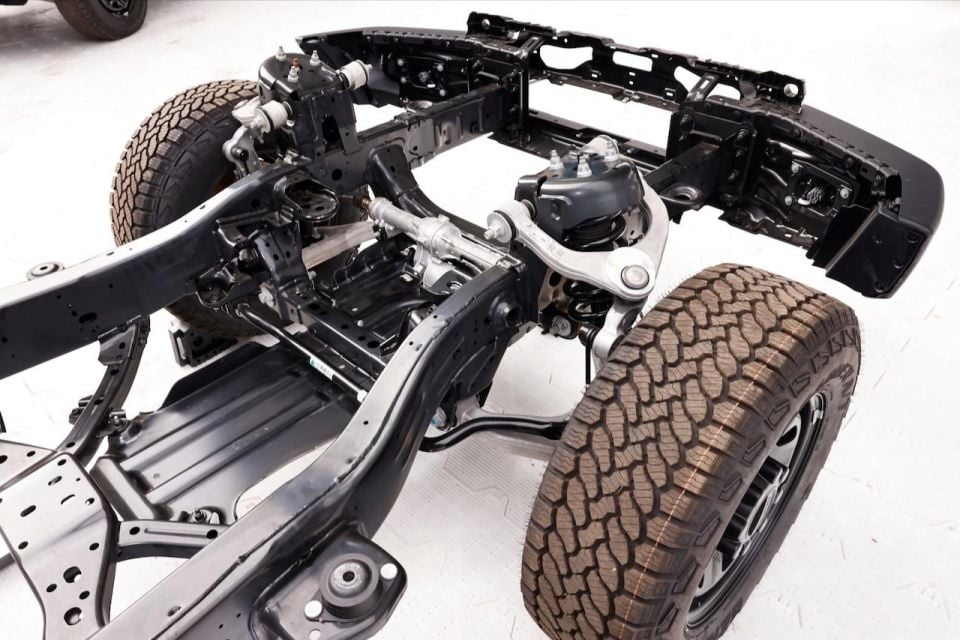
I wonder if Ford wouldn’t have been better off giving the Super Duty a new nose and calling it the F-100, sacrilege as it sounds?
The rear leaf springs have been lengthened and strengthened, the brakes are bigger, the engine’s cooling fan is now 25 per cent more powerful, the transfer case has also been changed and the transmission retuned, and the long-range fuel tank has 4mm of armour plating – doubled in some places – which can withstand the weight of the car (in case you get hung up on a large rock).
Starting to get the picture?
All of this was done for three main reasons: to make sure it can handle weight (whether towing or in the tray), to be more robust, and to get you where you’re going and back – again, and again.

But it doesn’t come at the cost of modern technology. For example, Ford has fitted a standalone Driver Assist Technology bar to the rear, which incorporates things like rear parking sensors, reversing camera, and safety aids, so drivers don’t lose those conveniences when a tray or box is fitted. There are also onboard weight scales and helpful towing aids.
The chassis upgrades mean the Ranger Super Duty has a gross vehicle mass (GVM) of 4500kg, the maximum weight possible before a truck licence is needed.
Gross combination mass (GCM) is 8000kg, with a braked towing capacity of 4500kg and a payload capability of between 1825kg and 1982kg, depending on the body chosen. In the process, Ford may have also inadvertently destroyed the industry responsible for doing GVM upgrades on Rangers.
So, the specifications may be impressive, but that’s just what the brochure tells us. What really matters is what the Ranger Super Duty is like in the real world.
How much does the Ford Ranger Super Duty cost?
For now, there are no trim grades, and buyers will have to wait until next year for style-side pickup versions with a tub, rather than the cab/chassis versions available now.
 ModelPrice before on-road costs2026 Ford Ranger Super Duty single-cab/chassis$82,9902026 Ford Ranger Super Duty super-cab/chassis$86,4902026 Ford Ranger Super Duty double-cab/chassis$89,990
ModelPrice before on-road costs2026 Ford Ranger Super Duty single-cab/chassis$82,9902026 Ford Ranger Super Duty super-cab/chassis$86,4902026 Ford Ranger Super Duty double-cab/chassis$89,990
Prices start at $82,990 before on-road costs for the single-cab, with the dual-cab costing $89,990 before on-roads. If you don’t carry passengers, the sweet spot is the extra-cab – known as the Super Cab in Ford parlance – which costs $86,490 before on-roads.
However, those prices are for a cab/chassis, meaning you’re going to be spending at least $6078 for a basic tray for your dual-cab from the factory. Ford offers three option packs, depending on whether the vehicle is likely to be used on a farm, for work, or for off-roading, with buyers able to choose a galvanised tray or a painted one in a selection of colours.
Pricing seems sharp initially, and the reality is these vehicles will cost around $90,000-$100,000 with a tray.
The luxurious Ranger Platinum and hardcore Ranger Raptor may be different flavours than the Super Duty, but it’s worth noting that while they are priced similarly, buyers will be paying Luxury Car Tax (LCT) on the standard Rangers – whereas the Super Duty is exempt.
For some who are looking at the Super Duty for towing, spending the extra for an F-150 may be worthwhile. Then again, compared to a 70 Series LandCruiser, the toughened-up Ranger looks something like a bargain.
To see how the Ford Ranger Super Duty lines up against the competition, check out our comparison tool
Let us help you find your new car
Buy your new car without the stress. It’s fast, simple and completely free.
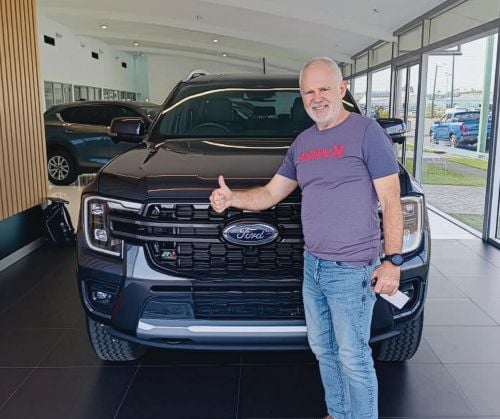
Great service from Travis and team, second time I have used this business would not hesitate to recommend them to anyone
Craig C.
Purchased a Ford Ranger in Sunshine Coast, QLD
CarExpert helped Craig save thousands on his Ford Ranger, now let us save you on your next new car.
Find a dealWhat is the Ford Ranger Super Duty like on the inside?
The cabin is one of the few things Ford hasn’t changed on the Ranger Super Duty.

For now, the Super Duty comes with cloth seat trim – plus eight-way manual seat adjustment for the driver, four-way for the passenger – and vinyl floor coverings. Carpet is optional.
But calling it base-spec suggests it isn’t well equipped, which isn’t the case. There’s dual-zone climate control, an 8.0-inch digital instrument cluster, a 12-inch portrait infotainment screen with DAB+ digital radio, satellite navigation, and wireless Apple CarPlay and Android Auto, as well as a wireless phone charger.
There’s a built-in electric brake controller for towing, and in the overhead console a bank of six auxiliary switches, allowing the owner to hook up spot lights, beacons, an air compressor, fridge, or whatever.
There are also two cupholders in the centre console, two pop-out cupholders in the dash, and drink bottle holders in each door.
Buyers can also option a removable metal bar designed for mounting auxiliary screens, controllers, or laptops, saving the interior from being hacked up – which is good for resale value.
While there are plenty of hard-wearing plastics, we did notice there was a step where some plastics meet on the lower part of the centre console, which looked like it could be a minor fitment issue.
Naturally, the single-cab doesn’t have much room for bags unless you’re riding solo, but there’s enough space to adjust the front seats so you’re not sitting bolt upright – unless you have particularly long legs.
The Super Cab – commonly known as the extra-cab – gains reverse-hinged half doors, which can only be accessed if the front doors are open.
In the back are basic bench seats, which are probably only useful for dropping colleagues off at their own cars down the road. But the seats can either fold up or down, revealing a decent amount of usable space – for storing bags, or even mounting a 12-volt fridge for those working (or playing) away from home.
Is it luxurious? No, but it is perfectly comfortable.
We spent hours behind the wheel on a mix of country roads, gravel roads, and proper High Country 4×4 tracks, and I was happy, even with me having the same body shape as Winnie the Pooh.
Ergonomics are spot on, with just a minor adjustment to move the seat forward/back and to the tilt-and-reach steering to find that ideal seating position.

If you’re coming from a higher grade of Ranger, you may miss some of the luxuries like heated seats, but if you’re coming from a 70 Series LandCruiser, it’s probably going to feel like you’ve stepped onto a spaceship.
Rest assured though, the controls are relatively straightforward and easy to learn, and the physical climate control knobs and the stereo shortcut buttons on the steering wheel mean you’re rarely delving into the menus on the screen to find what you need.
DimensionsSingle-cab/chassisSuper-cab/chassisDual-cab/chassisLength
(with tongue)5470mm
(5644mm)5470mm
(5644mm)5470mm
(5644mm)Width
(mirrors extended)2032mm
(2197mm)2032mm
(2197mm)2032mm
(2197mm)Height1983mm1977mm1985mmWheelbase3270mm3270mm3270mm
To see how the Ford Ranger Super Duty lines up against the competition, check out our comparison tool
What’s under the bonnet?
The Ford Ranger Super Duty couldn’t have come at a better time.
 SpecificationsFord Ranger Super DutyEngine3.0L turbo-diesel V6Power154kW @ 3250rpmTorque600Nm @ 1750rpmTransmission10-speed autoDrive typeFull-time 4WDEmissions standardEuro 6Fuel tank130 litresWeight (excluding tray)2518kgPayload1982kgBraked towing capacity4500kgGross vehicle mass (GVM)4500kgGross combination mass (GCM)8000kg
SpecificationsFord Ranger Super DutyEngine3.0L turbo-diesel V6Power154kW @ 3250rpmTorque600Nm @ 1750rpmTransmission10-speed autoDrive typeFull-time 4WDEmissions standardEuro 6Fuel tank130 litresWeight (excluding tray)2518kgPayload1982kgBraked towing capacity4500kgGross vehicle mass (GVM)4500kgGross combination mass (GCM)8000kg
Just as Ford’s Australian team was finalising development, Toyota announced the updated 70 Series LandCruiser was permanently dropping its beloved 4.5-litre turbo-diesel V8, leaving only the same 2.8-litre turbo-diesel four-cylinder engine found in the HiLux.
Despite Toyota’s 2.8 having almost the same power output – and 70Nm more – than the V8, those who live and work hours (and sometimes days) away from civilisation often prefer larger and less-stressed engines.
Enter the Super Duty, which is powered exclusively by the Ranger’s 3.0-litre turbo-diesel V6, putting out 154kW and 600Nm. More or less the same power as Toyota’s 2.8-litre engine, but with an additional 100Nm. Or 170Nm more than Toyota’s V8. However, the Super Duty’s engine has been detuned, with power reduced by 30kW from the standard Ranger’s 184kW.
With the Super Duty’s eight-tonne GCM, the vehicle moves into the N2 classification for commercial vehicles, requiring the addition of AdBlue to reduce tailpipe emissions. And in direct response to customer feedback, Ford now allows the driver to delay a DPF burn if it’s not safe or convenient.

While it would never happen due to emissions regulations, and would likely wipe out F-150 sales, we can’t help dream of what it would be like with a V8 – either the 5.0-litre ‘Coyote’ petrol V8 from the Mustang, which we know fits, or the 6.7-litre ‘Power Stroke’ diesel from the F-250. Boy howdy, that would be something.
Back in reality, drive is sent to all four wheels through a 10-speed automatic transmission, which most will be familiar with from the standard Ranger. But despite being a familiar transmission, many don’t realise how genius it is.
While it uses a torque converter for taking off from standstill in first and reverse, just like a traditional automatic, there are four planetary gear sets to change between 10 gear ratios, with six clutches employed for those gear changes.
The advantage is that – unlike traditional automatic transmissions – the torque converter is unlikely to overheat when towing or under heavy load. Meanwhile, the clutches aren’t used for initial take-off, which is where the greatest wear typically occurs on automatic dual-clutch gearboxes.
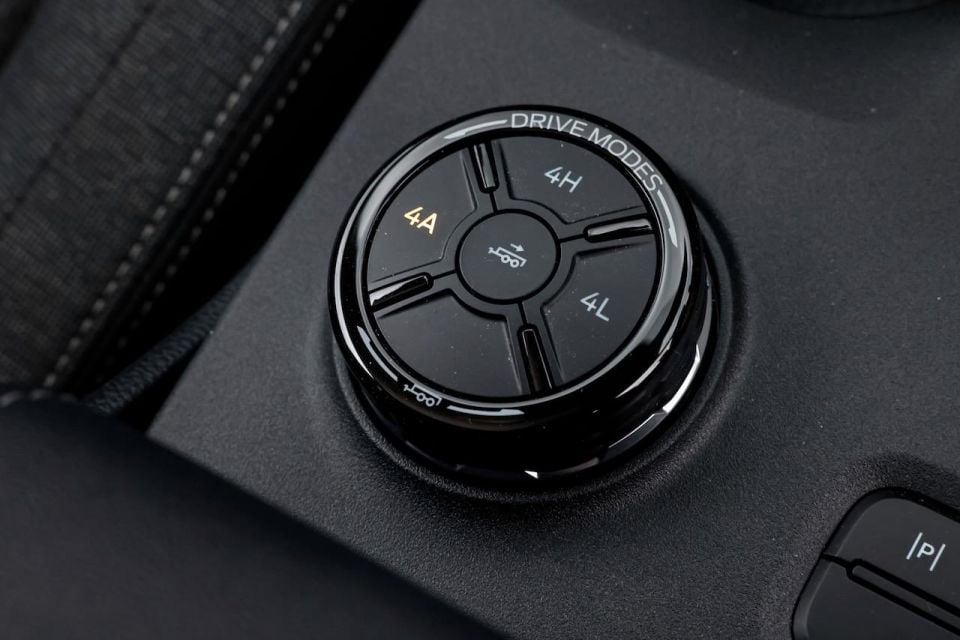
It’s essentially the best of several worlds – reducing the common cause of overheating and wear – while matching the right gear ratios with the torque of the V6, keeping the engine understressed.
Naturally, the Ranger Super Duty has a low-range gearbox for off-roading, with 4A being used on the open road – driving the rear wheels the majority of the time, but imperceptibly sending power to the front wheels when a loss of traction is detected, like in wet corners.
High- and low-range gearboxes are selected from buttons in the centre console, with the dial allowing different terrain modes to be chosen, based on the environment.
Front and rear locking differentials, hill-descent control, and trail turn assist – which can drag the rear inside wheel to help pivot the car on tight turns – are all accessed via the infotainment screen, while the speed of the hill-descent is selected using the cruise control buttons on the steering wheel.
To see how the Ford Ranger Super Duty lines up against the competition, check out our comparison tool
How does the Ford Ranger Super Duty drive?
Put simply, if you’ve driven a normal Ford Ranger, the Super Duty is quite similar – but like it’s had a high-protein diet and got a gym membership.

But it’s actually more impressive than that. Far more impressive.
Far and away, the most surprising thing about the Ranger Super Duty is its ride and handling.
Despite the heavy-duty chassis, the extra weight actually seems to help smooth out the ride, with no sign of those ‘bump echoes’ you can sometimes get from ladder-frame chassis utes.
Perhaps helped by the longer two-stage leaf packs, the comfort when unladen was especially good.
At times, I would even go so far as to claim it rides better than a normal Ranger. I know, I’m just as perplexed as you are.
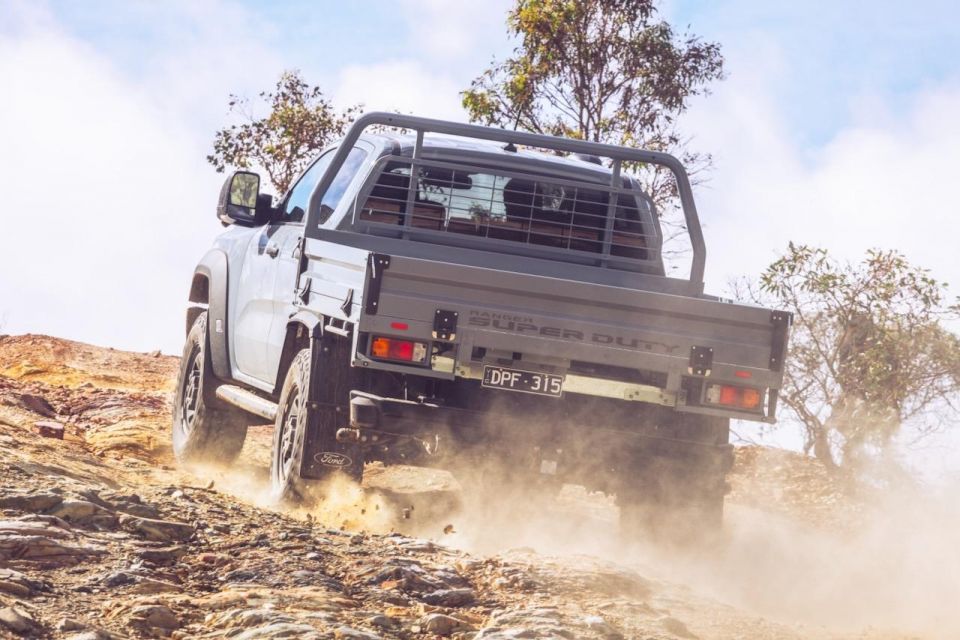 Trusted Reviews, Smarter Choices, Better Prices
Trusted Reviews, Smarter Choices, Better Prices
Where expert car reviews meet expert car buying – CarExpert gives you trusted advice, personalised service and real savings on your next new car.
This was particularly evident at higher speeds. While I started out doing my best to avoid Victoria’s large trademark potholes, by my second day behind the wheel, I was aiming for them.
Most of the time, the Super Duty was unperterbed, only reacting when we came upon a sinkhole or meteorite crater. Even then, the car seems to absorb the impact, isolating the occupants from any real discomfort, before settling quickly like nothing had happened. I can’t imagine how good this thing would be with some upgraded shock absorbers from Fox.
With performance unchanged from the standard Ranger, the additional bulk does mean it’s more relaxed during acceleration. It doesn’t feel slow – and there’s still plenty of torque and gear ratios available to get its boogy on – but it’s certainly not as eager as less Super models.
A few tonnes of construction equipment hooked onto the towball meant performance was, understandably, zapped. Still, the Ranger’s powertrain got the vehicle up to speed and up hills without fuss or fanfare, and neither ride nor handling was seriously compromised with a heavy trailer on the back.
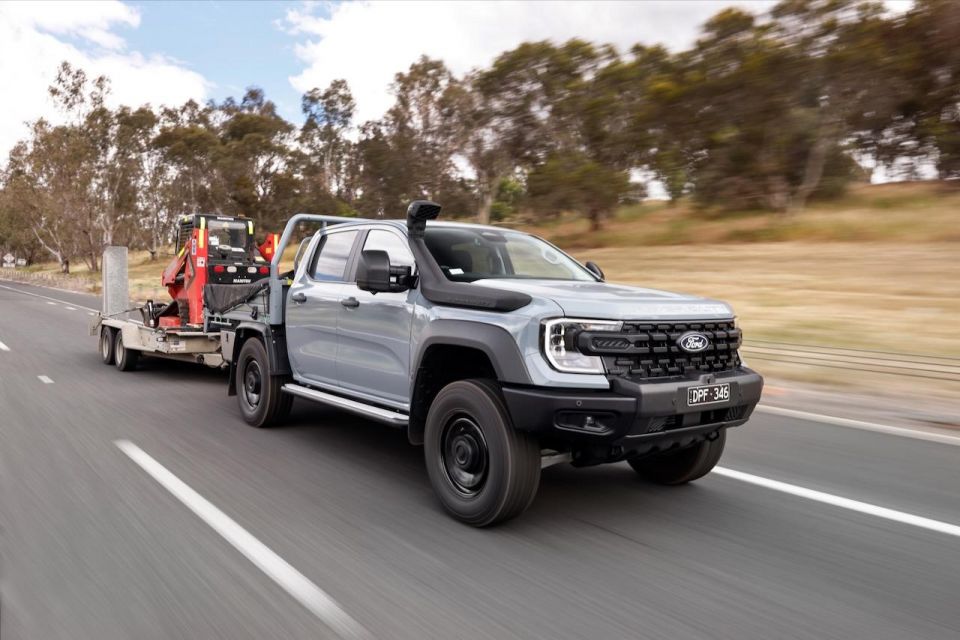
However, bigger vehicles like the Toyota LandCruiser 200 and 300 Series, Nissan Patrol, GMC Yukon, and Ford’s own F-150 seem to tackle the task of heavy towing more comfortably. But none of those can handle the Super Duty’s 4500kg towing capacity, aside from the Effie.
While you can feel the solidity and the additional weight that comes with the Ranger Super Duty, unladen, the handling is easily the best for a vehicle in this category. Of course, it’s not a Ferrari, but it also isn’t something you have to treat like a road train when you come upon a bend.
The 33-inch all-terrain General Grabbers surprised me with the amount of traction they provided on road – only giving a minor warble when pushed to their limits – but they still offered plenty enough grip when off-roading.
But it’s not just the tyres; the Ranger Super Duty has excellent mechanical grip – probably helped by the extra weight – though it’s clear as day that Ford’s people took pride in ensuring it drove well, too.
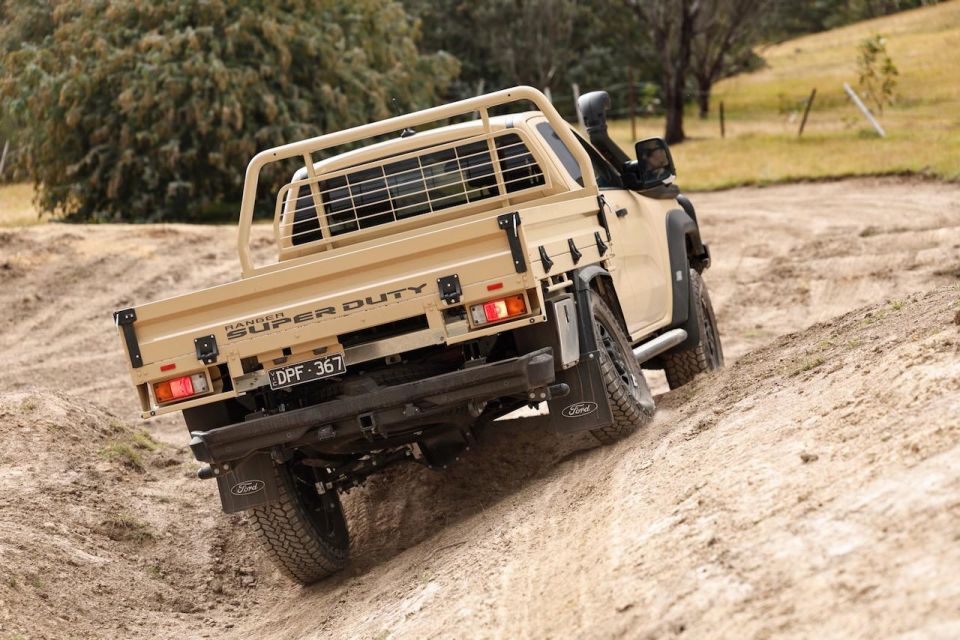
Off-road and in low-range, trying to manually select the right gear (using buttons on the side of the shift knob), finding the suitable terrain mode (twist the knob), engaging the hill-descent control (on the correct screen), and setting the speed (with the cruise control buttons) wasn’t always as simple as it sounds. When it worked, it worked well, but I couldn’t help thinking that getting down a steep hill with loose rocks used to be a lot simpler in older 4x4s.
The flipside of the same coin was that having a large screen with a front-facing camera means you can easily see the ground right ahead of you, even when you can only see sky through the windscreen. And I particularly enjoyed the underwater view when doing a river crossing.
Our particular test vehicle also didn’t want to engage the Trail Turn Assist feature immediately, but after a few goes engaging and disengaging the rear diff lock and rolling the car back and forward, it decided to play ball.
We had plenty of opportunities to get the Super Duty on three wheels, and the rears offered a surprising amount of articulation and travel at the extremes. It’s not quite at rock-crawler levels but, like the fat bloke in the yoga class, showed off more flexibility than expected.
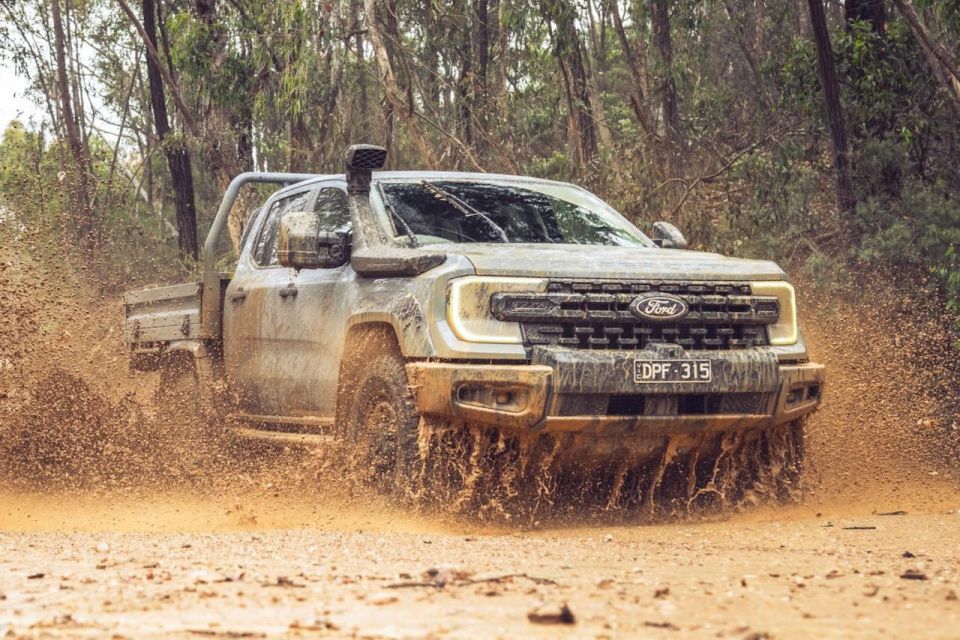 Off-road dimensionsSingle-cab/chassisSuper-cab/chassisDual-cab/chassisTrack front and rear1710mm1710mm1710mmGround clearance299mm297mm295mmApproach angle36.336.236.1Departure angle29.329.028.6Ramp breakover angle26.926.526.3Wading depth850mm850mm850mm
Off-road dimensionsSingle-cab/chassisSuper-cab/chassisDual-cab/chassisTrack front and rear1710mm1710mm1710mmGround clearance299mm297mm295mmApproach angle36.336.236.1Departure angle29.329.028.6Ramp breakover angle26.926.526.3Wading depth850mm850mm850mm
To see how the Ford Ranger Super Duty lines up against the competition, check out our comparison tool
What do you get?
When it comes to the Ranger Super Duty, Ford giveth and Ford taketh away, with some of the more luxurious features not available on the workhorse, but it gains plenty of extras to help those out in the field.
2026 Ford Ranger Super Duty cab/chassis equipment highlights:
Automatic LED headlightsLED front fog lightsZone lightingRain-sensing wipersProximity entry with push-button start18-inch steel wheels with eight-stud wheel hubGeneral Grabber A/T LT 275/70 R18 tyres18-inch spare steel wheelComposite side stepsOnboard scalesPro Trailer Back-up AssistIntegrated trailer brake controller4.5T compatible tow bar and hitch2 x front rated recovery points2 x rear rated recovery pointsMoulded mud guardsHeavy-duty mount kitTrail ControlTrail Turn AssistHill descent controlPower-folding, heated exterior mirrorsPuddle lightsSelectable drive modes (Eco, Tow/Haul, Slippery, Mud/Ruts, Sand, Rock Crawl)Cloth upholsteryVinyl floors8-way manual driver’s seat4-way manual passenger seatSteering wheel height and reach adjustmentElectric park brakeElectro-chromatic rear-view mirror8.0-inch digital instrument cluster12-inch touchscreen infotainment systemWireless Apple CarPlay and Android AutoSatellite navigationDAB+ digital radio2-speaker sound system (single cab/chassis)6-speaker sound system (super and double cab/chassis)Wireless phone chargerDual-zone climate controlAuxiliary switch bank (6 x switches)400W 230V inverter (rear of centre console)
Along with a decent list of optional extras, Ford offers The Farm Pack, The Work Pack, and The Adventure Pack, which are designed to anticipate the needs of those in different sectors.
For the full list of options and what they entail, head to our pricing and specifications article by clicking here.
To see how the Ford Ranger Super Duty lines up against the competition, check out our comparison tool
Is the Ford Ranger Super Duty safe?
Given how different it is from the standard Ranger, the ANCAP score given to its sibling is unlikely to provide a realistic gauge of the Super Duty’s safety, so we’ll have to wait and see whether the vehicle is independently crash tested and how it performs.

2026 Ford Ranger Super Duty safety equipment:
Adaptive cruise control with stop/goAutonomous emergency brakingBlind-spot monitoring with Cross Traffic Assist and trailer coverageEvasive Steer AssistLane centringLane-keep assistTraffic sign recognitionFront and rear parking sensorsSurround-view cameraTyre pressure monitoring9 x airbagsFrontSideKneeCurtainDriver far side
To see how the Ford Ranger Super Duty lines up against the competition, check out our comparison tool
How much does the Ford Ranger Super Duty cost to run?
The Ranger Super Duty comes with Ford’s five-year, unlimited-kilometre warranty, along with up to seven years of roadside assistance – provided the vehicle is serviced annually at a Ford dealership.
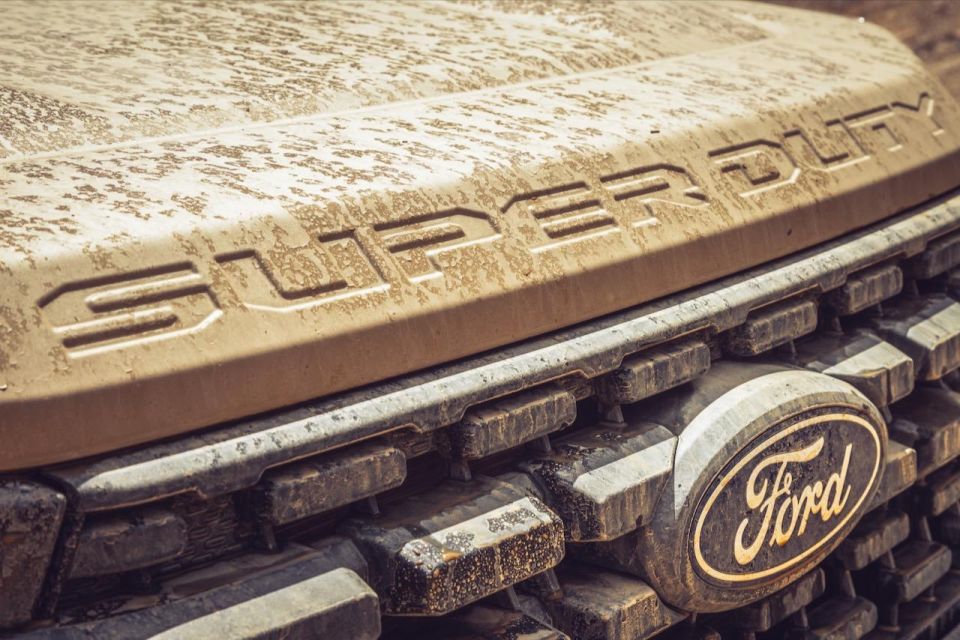 Servicing and WarrantyFord Ranger Super DutyWarranty5 years, unlimited kilometresRoadside assistance7 years (conditional)Service intervals15,000km/12 monthsCapped-price servicing$469Average annual service cost$469Total capped-price service cost$2345
Servicing and WarrantyFord Ranger Super DutyWarranty5 years, unlimited kilometresRoadside assistance7 years (conditional)Service intervals15,000km/12 monthsCapped-price servicing$469Average annual service cost$469Total capped-price service cost$2345
Service intervals are 15,000km or 12 months (whichever comes first), with the capped-price services from a Ford dealership costing $469 for the first five years or 75,000km.
While our time with the Ranger Super Duty was limited at the launch, we saw relatively consistent fuel consumption figures of around 7.0L/100km, give or take. We’re looking forward to getting one into the CarExpert office in the near future to check those numbers in more diverse environments. But with its 130-litre fuel tank, that suggests a pretty crazy driving range capability.
To see how the Ford Ranger Super Duty lines up against the competition, check out our comparison tool
CarExpert’s Take on the Ford Ranger Super Duty
I personally have a soft spot for the Toyota LandCruiser 70 Series. It’s been the unsung hero of Australia’s agriculture and mining industries for almost half a century. But with the Ranger Super Duty, Ford just read the LC70 its last rites.
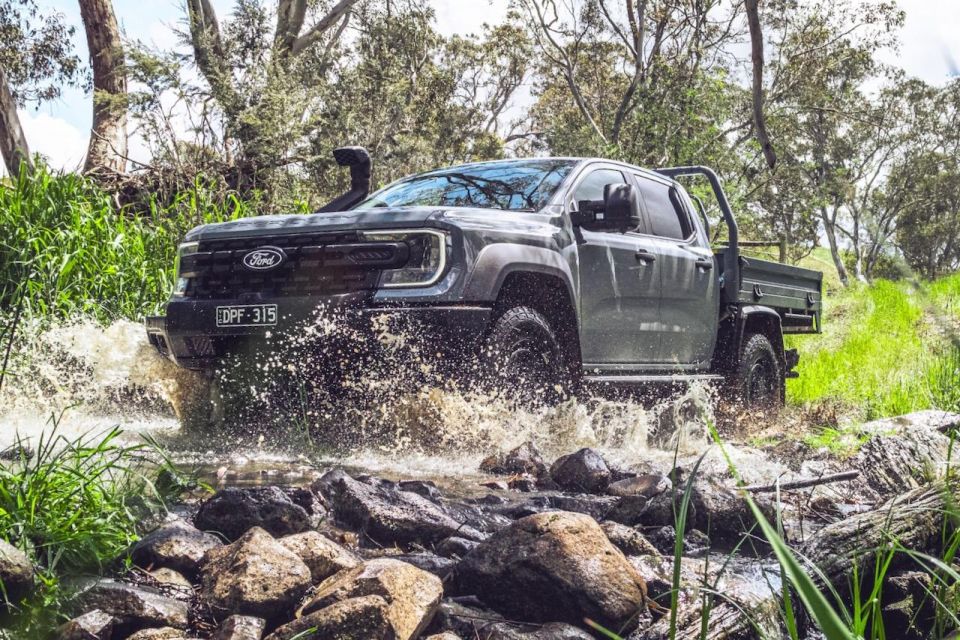
The Ranger Super Duty surprised me at every turn. It is almost without compromise for a vehicle in this segment, yet it offers specifications that will attract buyers from other segments, too – like those considering far more expensive American full-size pickups, and those who have traditionally bought Toyota LandCruiser SUVs and Nissan Patrols as family haulers.
Despite the large screen and digital dash – which are almost unavoidable nowadays – I suspect Grey Nomads will love the Super Duty’s build quality and no-nonsense approach. Organisations that conduct work out in the field will no longer have to choose between payload, capability, and modern safety features.
Ford has been clever with this ute. Little details like onboard scales, Smart Hitch – which can tell the driver the tow ball down-weight – as well as an electronic brake controller, Pro-Trailer Backup Assist, and the Driver Assist Technology bar, which adds reverse parking sensors and the full suite of ADAS technology, is proof its engineers really were listening.
The Super Duty also has a bit of an X-factor. Australians love tough cars, but there’s a bit of a tall poppy syndrome when it comes to flashy cars. The Ford appeals to those sensibilities, where driving a somewhat expensive commercial vehicle is more socially acceptable than driving around in a vehicle that looks expensive.
There’s no leather, no carpet even, and some of the plastic interior pieces didn’t seem to align perfectly on close inspection, and aside from some frustrations with its off-road trickery, there aren’t many negative things to say about the Super Duty. It’s kinda big to park, I guess, and it’s a fair bit wider than a 70 Series, so expect some scratches down the sides on tight bush tracks.
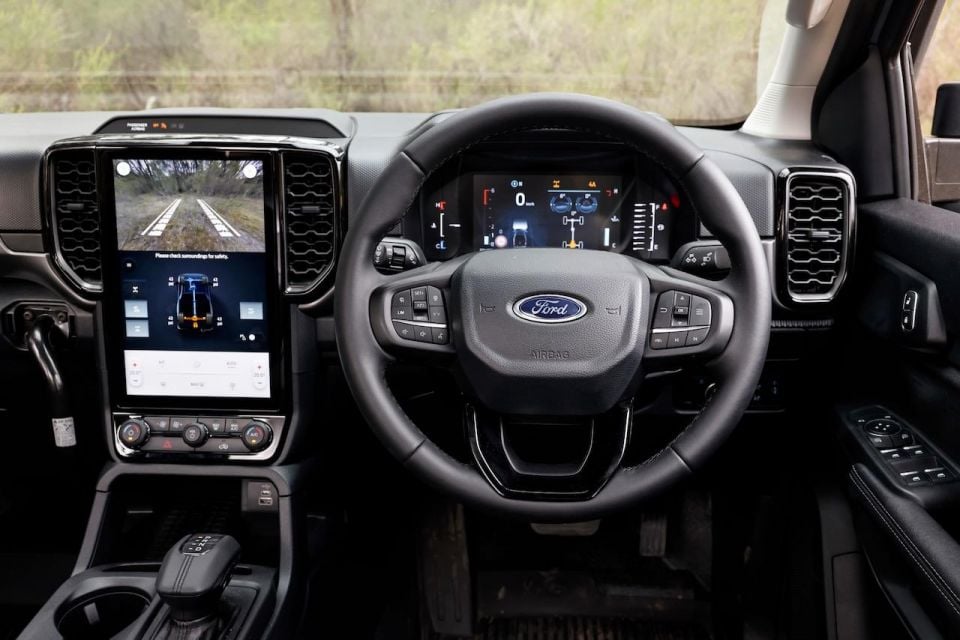
Arguably, the biggest question mark remains over the Super Duty’s diesel V6. Early versions of this engine were prone to problems, though Ford’s engineers assure us they have addressed each of them, and buyers no longer have anything to worry about.
Yet it’s hard to imagine the Ranger Super Duty will cover the best part of a million kilometres on a single engine, as was the case with diesel 70 Series utes of the 1980s and ’90s – but then again, it’s hard to know whether Toyota’s 2.8-litre four-cylinder engine will offer that kind of longevity, either. Maybe those days are over, maybe not.
It will be interesting to see whether ringers on cattle stations across outback Australia embrace the Ranger Super Duty, as they ultimately have the last word on the longevity and robustness of a car.
Regardless, the team behind the Ranger Super Duty has not only listened to their customers, but tried to anticipate their wants and needs, and not spared any expense in engineering this vehicle to be capable and long-lasting. It’s not a marketing slogan, they’ve actually done it – and it shows.
Ford Australia is clearly very proud of this vehicle, and its people have every right to be. It is a rolling testimonial to the talents of our automotive industry, almost a decade after it was announced that local manufacturing would cease. Ford may no longer manufacture them here, but its Aussie engineers sure as hell know how to make ’em.
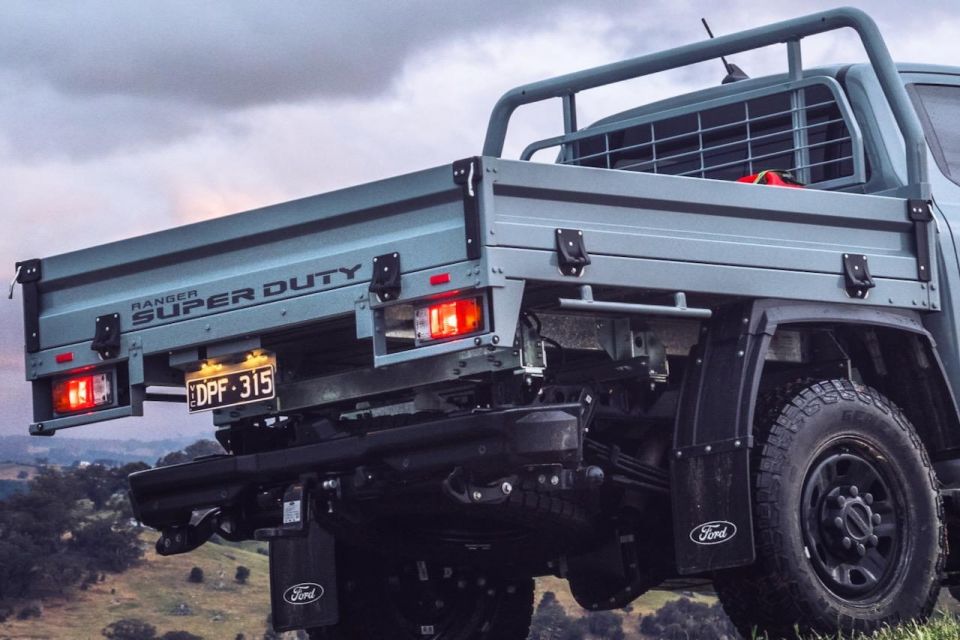
CarExpert can save you thousands on a new Ford Ranger Super Duty. Click here to get a great deal.
Click the images for the full gallery

